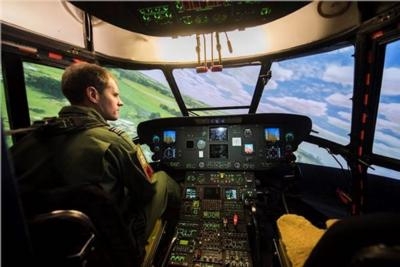Mon, Oct 30, 2017
Sims Replicate Real-Life Scenarios
The U.K. Ministry of Defense has announced an over £90 million (approx. $119 million) investment in a world-leading helicopter simulation center to help train the Royal Air Force and Royal Navy helicopter pilots of the future.

The simulators put pilots through their paces, replicating extreme real-life scenarios, from flying in blizzards or under enemy fire to dealing with power failures and electronic warfare. The deal will sustain 70 jobs at the Medium Support Helicopter Aircrew Training Facility based at RAF Benson in South Oxfordshire.
Defense, Equipment and Support, the MOD’s procurement organisation, signed a contract amendment with simulator specialist CAE Aircrew Training Services to deliver training for Chinook, Puma and Merlin aircrews at a purpose-built facility, extending the use of CAE’s current contract for another 8 years.
The equipment provides a realistic representation of the operating environments in which the the crews will fly, including emergency situations like the effects of icing and rotor blade damage, the impact of gun or missile fire and electronic warfare, total electrics failure and fuel management issues.
The contract will deliver training for Chinook and Puma aircrews until the Puma planned out-of-service date. Training for the Merlin Mk3 will continue at the facility for at least two more years as the Royal Navy transitions from the Mk3 to the Mk4 helicopter. The center is equipped with six CAE-built dynamic mission simulators (three Chinook, two Merlin and one Puma), four computer-based ground school training classrooms and a Tactical Control Centre that allows for operational mission training.
'The importance of effective synthetic training cannot be underestimated and continues to play an increasingly important role in our overall training curriculum," said Adrian Baguley, Director Air Support at the MOD’s Defense Equipment and Support. 'The Medium Support Helicopter Aircrew Training Facility has consistently delivered a high standard of quality training to the operators of our front line helicopter capabilities. This agreement continues to maintain the world-leading ground school and simulator training facility for our helicopter aircrews.'
(Images provided with U.K. MOD news release)
More News
A Puff Of Smoke Came Out From The Top Of The Engine Cowling Followed By A Total Loss Of Engine Power On May 9, 2025, about 1020 mountain daylight time, an experimental amateur-buil>[...]
From 2022 (YouTube Edition): Jenny, I’ve Got Your Number... Among the magnificent antique aircraft on display at EAA’s AirVenture 2022 was a 1918 Curtiss Jenny painstak>[...]
Very High Frequency (VHF) The frequency band between 30 and 300 MHz. Portions of this band, 108 to 118 MHz, are used for certain NAVAIDs; 118 to 136 MHz are used for civil air/grou>[...]
“From approximately November 2021 through January 2022, Britton-Harr, acting on behalf of AeroVanti, entered into lease-purchase agreements for five Piaggio-manufactured airc>[...]
Microburst A small downburst with outbursts of damaging winds extending 2.5 miles or less. In spite of its small horizontal scale, an intense microburst could induce wind speeds as>[...]
 NTSB Prelim: Lee Aviation LLC JA30 SuperStol
NTSB Prelim: Lee Aviation LLC JA30 SuperStol Classic Aero-TV: Curtiss Jenny Build Wows AirVenture Crowds
Classic Aero-TV: Curtiss Jenny Build Wows AirVenture Crowds ANN's Daily Aero-Term (05.30.25): Very High Frequency (VHF)
ANN's Daily Aero-Term (05.30.25): Very High Frequency (VHF) Aero-News: Quote of the Day (05.30.25)
Aero-News: Quote of the Day (05.30.25) ANN's Daily Aero-Term (05.31.25): Microburst
ANN's Daily Aero-Term (05.31.25): Microburst



